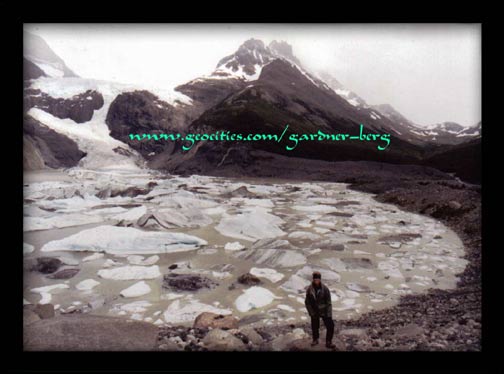
Los Perros Glacier, Paine Circuit, CHILE
| Translate: EspaŮol - FranÁais - Deutsch - Italiano - PortuguÍs - Japanese - Korean - Chinese |

Los Perros Glacier, Paine Circuit, CHILE
| Translate: EspaŮol - FranÁais - Deutsch - Italiano - PortuguÍs - Japanese - Korean - Chinese |

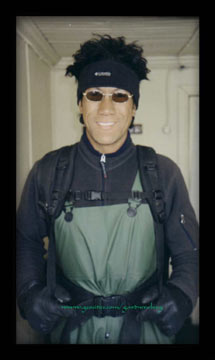 JANUARY 22, 2001 -- After a very good sleep at Campo Municipal we begin preparations for Tierra del Fuego. Our plan is to take a short bus ride across the border to Puerto Natales, Chile; stay a few nights then bus down to Ushuaia, Argentina. This involves a short ferry ride in between.
JANUARY 22, 2001 -- After a very good sleep at Campo Municipal we begin preparations for Tierra del Fuego. Our plan is to take a short bus ride across the border to Puerto Natales, Chile; stay a few nights then bus down to Ushuaia, Argentina. This involves a short ferry ride in between.
JANUARY 23, 2001 -- A cold and windy day during the border crossing at Rio Turbio arriving in Puerto Natales at 1pm. A short walk from the bus office through quiet streets, to accommodation run by a friendly Chileno family. Very homely, great breakfasts (free) with their homemade rhubarb jam and cheeses.
A lot of the stores in the small town of Natales revolve mainly around trekking and climbing. This is where one could outfit oneself more or less adequately for the circuit trek around Torres del Paine or the 'Paine Circuit'. During our stroll, a huge wall map posted outside a trek tour and equipment store, attracted our attention. It was a semi topograghical map of the Parque Nacional Torres del Paine and the various trail routes within the park. We looked at the map for a good hour or so and after much discussion between ourselves, we decide to change our plans slightly...
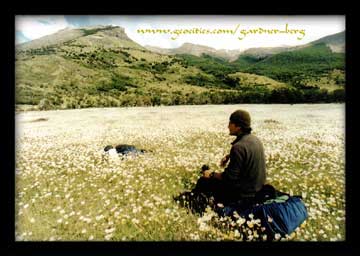
The next day was devoted to preparation for one of the trek routes around Torres del Paine (Paine Towers) - supplies, fuel, extra clothing and, with later regret, cheap workmans' rainwear.
JANUARY 26, 2001 -- (7am) We begin the day with a 2 hour bus ride from Puerto Natales to the ranger station at Laguna Amarga - National Park entrance. The weather today is cloudy but warm. The guards are in good spirits, as we sign in and pay the entrance fee. After last minute checks on our gear, supplies and route map, we head on out.
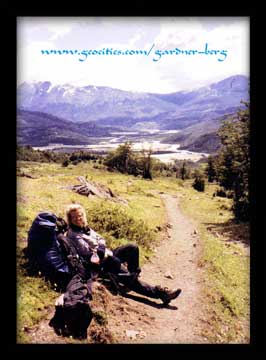 We follow a dusty gravel road west of the lake for about 2 hours to our first stop - Camp Las Torres. Nice site, quite touristy, good facilities, firewood supplied etc., but for US$6 per person a night - we thought it was ridiculous.
We follow a dusty gravel road west of the lake for about 2 hours to our first stop - Camp Las Torres. Nice site, quite touristy, good facilities, firewood supplied etc., but for US$6 per person a night - we thought it was ridiculous.
JANUARY 27, 2001 -- (10am) Exit Las Torres camp and head north crossing lands that were once used for grazing livestock before becoming a National Park. Slowly, as the trail edges more and more closer to the Rio Paine, the green paddocks abruptly change color. We're confronted with huge fields of daisies - not a good thing for allergy sufferers and seemingly in the centre of 'Daisyland' is the campsite of Seron - where we spend the night. We had to argue with the guard there about the price - it was the same as the last site but here there were no facilities (LPG tanks for heating water were empty) and wood fires were prohibited. He agreed to half price (which he confessed was reserved for Argentinos and Chilenos).
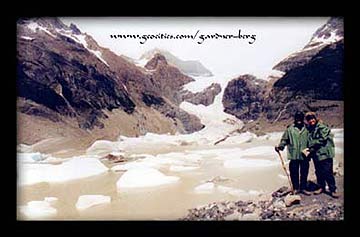
So far, we're feeling pretty good apart from a few blisters, our packs are a little heavy. The weather, a little more cloudy, but still warm.
JANUARY 28, 2001 -- (Noon) Still following the Rio Paine, the trail turns west passing Paine Lake towards it's western inlet where Camp Coiron is situated. It's a free site with no facilities and overrun by aggressive mosquitos.
Blisters have gotten worse. These boots, purchased at a market in the Peruvian highlands, are not designed for this kind of abuse.
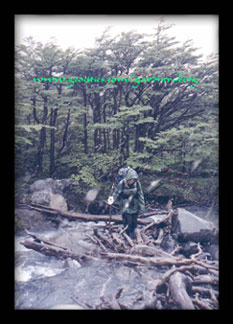
JANUARY 29, 2001 -- The morning was spent draining and covering blisters; repairing boots with duct tape and toilet paper. We hit the trail at noon. Patchy weather today, no rain but getting cooler. We begin to see more of the snowy mountains in the distance, and that means we will soon witness a few glaciers. A campsite at the southern end of Lake Dickson gives us a first taste of coming attractions - the distant Glaciar Dickson to the north hiding behind a layer of mist. We arrive at Camp Dickson just before a downpour of rain.
 JANUARY 30, 2001 -- (10.30am) Exit Camp Dickson on a slow ascent of a glacial lake of Los Perros. Blisters begin to take their toll again; the trail leads
into a wooded area. But the healing was not made any easier from the countless fallen trees over the path. It was a long day. We did, however, find a couple of branches to serve us as walking poles. From that time forward, these makeshift trekking poles would become our most valuable pieces of equipment on the entire hike.
JANUARY 30, 2001 -- (10.30am) Exit Camp Dickson on a slow ascent of a glacial lake of Los Perros. Blisters begin to take their toll again; the trail leads
into a wooded area. But the healing was not made any easier from the countless fallen trees over the path. It was a long day. We did, however, find a couple of branches to serve us as walking poles. From that time forward, these makeshift trekking poles would become our most valuable pieces of equipment on the entire hike.
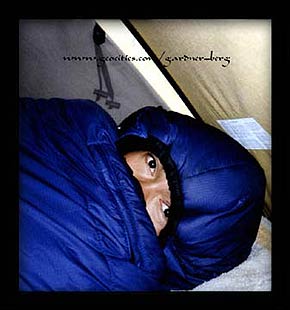 After a few river crossings on suspect bridges we arrive at Glaciar Los Perros. It's icy snout flakes away chunks of ice into the silt waters of the lake that looks more like a crater. The westerlies are strong and cold here, cutting right through us. We quickly set up camp and get a hot meal going.
After a few river crossings on suspect bridges we arrive at Glaciar Los Perros. It's icy snout flakes away chunks of ice into the silt waters of the lake that looks more like a crater. The westerlies are strong and cold here, cutting right through us. We quickly set up camp and get a hot meal going.
We decide to stay an extra night here to dry our clothing, take a few photos of the glacier and nurse those blisters.
FEBRUARY 1, 2001 -- Pretty cold this morning as we head west out of the campsite. It begins to rain as we negotiate an uphill, muddy section of dense forest. Rain turns to snow and our half-dried clothing becomes completely soaked. The horribly muddy area took us 2 hours to get through and we really had to stop and camp wild. We chose a spot by the river (Rio Paso) just before
the John Garner Pass, and wait out the snowfall and once again try and dry our gear. It was a good idea - we wouldn't have been able to see the orange trail
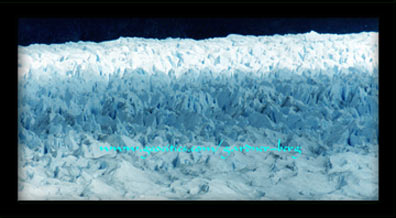 markers across the 'Pass' anyway. Our wonderfully cheap workman's rainwear is already torn and cracked after only 2 uses. Considering the wet conditions and lack of good gear, we thought we were doing OK so far. No signs of hypothermia, plenty of food and fuel to last 10 more nights if need be. Having a great time - wish you were here.
markers across the 'Pass' anyway. Our wonderfully cheap workman's rainwear is already torn and cracked after only 2 uses. Considering the wet conditions and lack of good gear, we thought we were doing OK so far. No signs of hypothermia, plenty of food and fuel to last 10 more nights if need be. Having a great time - wish you were here.
FEBRUARY 2, 2001 -- Snow again this morning and late afternoon. Blisters are recovering thanks to the walking stick. There's something about looking through an opening of a small tent at the sight of heavy snow being carried by waves of strong winds making no sound when they hit the treetops.
 FEBRUARY 3, 2001 -- Our gear now dry enough to keep us warm - we quickly pack and commence to charge ahead while the snow is light to the 'Pass'. Visibility
around 500m and some of the snow drifts were hip high. The orange markers were
sometimes difficult to spot. At the 'Pass', groups of trekkers quickly catch up to us and practically fly past. Today, the John Garner Pass did not promise us any of the expected grand views of the Campo de Hielo Sur icecap and its Grey Glacier below - it was a white-out.
FEBRUARY 3, 2001 -- Our gear now dry enough to keep us warm - we quickly pack and commence to charge ahead while the snow is light to the 'Pass'. Visibility
around 500m and some of the snow drifts were hip high. The orange markers were
sometimes difficult to spot. At the 'Pass', groups of trekkers quickly catch up to us and practically fly past. Today, the John Garner Pass did not promise us any of the expected grand views of the Campo de Hielo Sur icecap and its Grey Glacier below - it was a white-out.
The descent to the next campsite (Paso) was steep, and very slippery from mud and ice. We lost count of the number of falls, bellowing just about every swear
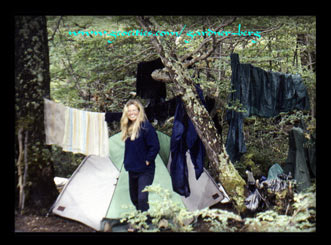 word known in the English language. This section was wooded enough, however, to
stop some potentially severe falls. But, by the time we arrive at the 'Campamento Paso' our rainwear was beyond repair. And to end the day on a good note, that cold rain makes one more visit as we set up our tent.
word known in the English language. This section was wooded enough, however, to
stop some potentially severe falls. But, by the time we arrive at the 'Campamento Paso' our rainwear was beyond repair. And to end the day on a good note, that cold rain makes one more visit as we set up our tent.
An extra night stay provides a chance to once again dry and organise our gear.
The vast field of ice was an eerie but spectacular sight for both of us. Eerie in the sense that despite the huge area it covers, this slow moving behemoth of nature is ever so silent. One can easily explain the 'cause and effect' of ice
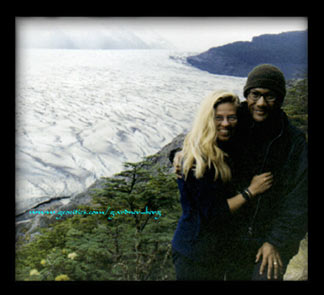 field formation from a scientific standpoint, but to reason its beauty? We just sat there for 2 hours just gazing.
field formation from a scientific standpoint, but to reason its beauty? We just sat there for 2 hours just gazing.
FEBRUARY 5, 2001 -- Snow early this morning. But the next section of trail was better. We made good time southbound to Camp Grey, passing a few friendly day-hikers on the way. Great views of Glaciar Grey and its lake of meltwater and icebergs. Strong winds at this lakeside campsite but our gear dries double-quick. A good feeling.
FEBRUARY 6, 2001 -- (11am) Cloudy skies - weather holding, the trail becomes more and more groomed, bridges built better, track is faster and easier. We pass a lot more day-hikers heading to Glaciar Grey.
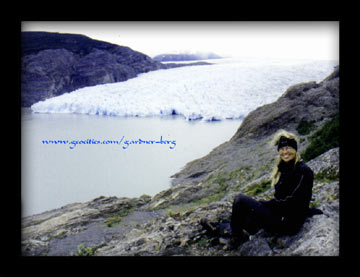
Unfortunately, at around noon, the weather deteriorates. Strong winds and cold rains falls heavily as we descend to Lake Pehoe. Cold and soaked once again and on top of that, a 5 hour wait outside for the boat to ferry us to Pudeto where buses going to Puerto Natales await. But aside from the anti-climactic finish to our small part of the National Park trails - this rates as a highlight of our Latin American journey so far.
10.30pm - Our friendly hosts at the guesthouse welcome our weary bodies back in.
Photos and Text Copyright © 1999-2001 Gardner-Berg. All rights reserved.
Sources of Further Reading-
Falkner, Thomas. "Description of Patagonia and the Adjoining Parts of South America" 1978
Hatcher, John B. "Bone Hunters in Patagonia: Narrative of the Expedition" 1985.
Hudson, W.H. "Idle Days in Patagonia" 1968.

